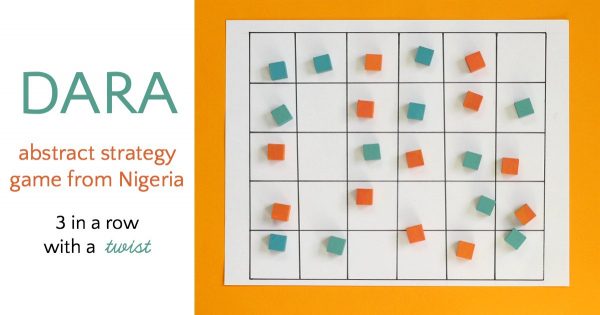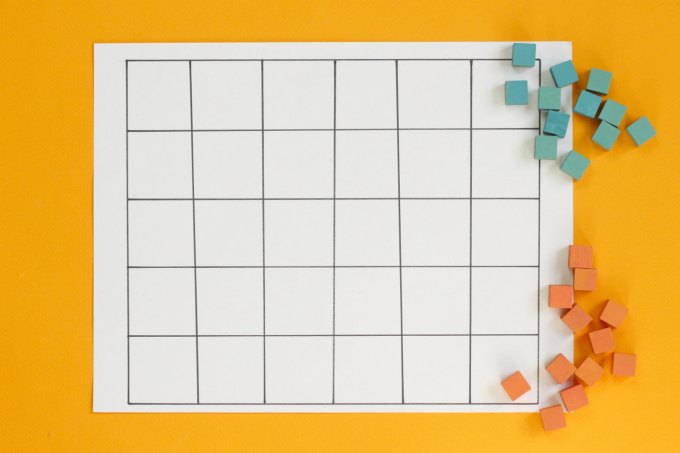Are you ready for a super cool 3 in a row game from Northwest Africa? All of the other traditional three in a row games I've shared, such as Tapatan and Nine Holes have had one thing in common. The game ends when a player makes a row with 3 of his token. But Dara, a game played in Nigeria by the Dakakari people, as well as in Niger and Mali, does not end with the first 3 in a row!

Because of this, the rules take a bit longer to learn (but not much) and a good strategy is harder to discern. However, these differences are what makes it much more exciting, especially for older kids. Overall, it is not difficult but you really have to pay attention to the board and plan ahead. In fact, I think this is probably a great warm up game for kids who are learning how to play chess. And incidentally, I really dislike chess (surprising, I know), but I love Dara.
How to Play Dara
What you need:
- 12 tokens, in two colors. You can pilfer tokens from your games closet, or use button, coins or other small objects.
- Game board set out in a 6x5 grid. Make your own, or download ours here.
- 2 players eager to become champions.
Objective: To capture your opponents tokens so that he can no longer make three in a row. (In other words, until he has only 2 tokens left.)

Instructions:
There are two phases. The "drop phase" and the "move phase". This is similar to several other traditional games we have shared.
Drop phase:
- Decide who goes first.
- Players alternate placing their tokens on the game board.
Once all tokens have been placed, the move phase begins.
Move phase:
- Players take turns moving their tokens, one at a time, in an attempt to make 3 in a row. Once a player has made three in a row, he can remove one of his opponent's tokens from the board.
Constraints:
- You may not have more that 3 tokens in a row. (So -- no 4 in a row, for example.) Note: I have come across some instructions which do allow for 4 or more tokens to be in a row. (Discrepancy in rules is common for traditional games.)
- Optional: You are not allowed to make 3 in a row during the drop phase. Even if you allow players to make 3 in a row during the drop phase, you may not remove your opponents token during the drop phase.
- You may not capture an opponents token when it is part of a 3 in row he made.
- Rows of three may only be orthogonally (there's a new word for you!), not diagonally.
- No diagonal moves are allowed.
Watch our video to see the game in action.
Why your kids should play Dara:
Dara is an abstract strategy game, rather than a game of chance. It enhances observation skills, critical thinking, planning ahead, spatial perception and number sense. As you might guess, these are great pre-math skills but they are also important for things like logical thinking, and even handwriting! (Plus, fine motor work is in there, too.)
About Dara:
Dara is traditionally played with stones and holes dug in the ground. Our version uses a checkerboard grid because that makes it easier to play at the table. But why not try it at the beach, or at the campsite? You won't need any equipment but what you can scavenge! Sticks vs. stones, or daisies vs. dandelions, perhaps?
If your kids loved playing Dara, they will love these games, too:
- Solitary Strategy Game: Tchuka Ruma
- Fox and Geese: A Traditional Abstract Strategy Game
- Len Choa: Leopards and Tiger Game from Thailand
- Five Field Kono: Abstract Strategy Game from Korea
- Watermelon Chess, a battle game from China
Don't miss out on any of the games we share! Subscribe to our newsletter for tons of ideas to get your kids brains stretching and learning.



Thalisu says
please we need Dara game application .Thanks
myworldtheirway says
Loved the game. Please check out couple of math game ideas on my blog https://myworldtheirway.wordpress.com/
Sandy says
Awesome! Can't wait to try this out when my kids get out of the bath!
Amy says
This is so great! Thank you, thank you!
Catherinec says
Is it permitted to get three in a row, and then move your token out of the row and back again repeatedly?
johnhenry says
Have you tried Hijira ( https://www.boardgamegeek.com/boardgame/824/hijara )? I learned it while in the Navy, and a lot of us on the ship thoroughly enjoyed it. It's an interesting twist on 4-in-a-row games; in this one, you play until the board is filled and compute your score based on the different scoring combinations.
Erica says
I haven't played it. Thanks for the suggestion, I'll check it out.
Wilson says
In your instructions you say that a row of 3 may only be orthogonal, which is a 90 degree angle, but in your video you play that 3 in a row can be horizontal or vertical.